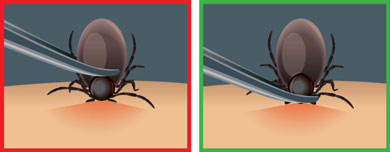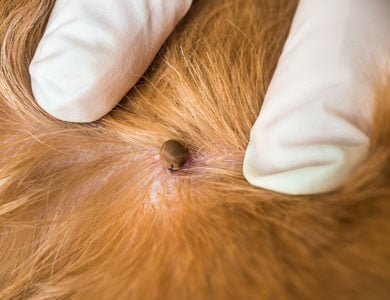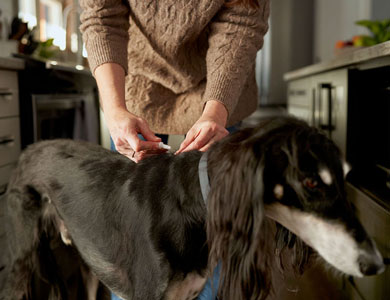Ticks have been spreading throughout the province for several years, posing a significant threat to humans and animals. These tiny mites, just a few millimetres in size, can cause severe health issues for dogs. Therefore, taking preventive measures and knowing how to react if your dog gets bitten is crucial.

Where can ticks be found?
Ticks usually live in forests and wooded areas but can also be found in hedges, bushes, gardens, tall grass and other urban areas . Since they cannot fly or jump, ticks travel on animals. They wait for their prey to walk past and then attach themselves firmly to them.
Detecting ticks
Early detection of ticks is essential to prevent the transmission of potentially severe diseases. It is advisable to pat your pet from the tip of their muzzle to the tip of their tail within two hours of any outdoor activity. These little massages will not only be appreciated by your pooch but will also aid in preventing potential problems, particularly if you combine them with topical protection.
Pay particular attention to certain parts of the body:
- Ears: ticks particularly like the moisture and warmth of a dog's ears. It's essential to check this area meticulously, paying particular attention to the ear folds.
- Neck and head: ticks can be found in the fur on the neck and around the head, including between the eyes and behind the ears.
- Between toes and pads: check these often overlooked areas carefully.
- Groin and belly: ticks can lodge in sensitive areas of the groin and abdomen. Careful inspection is necessary to spot these parasites.
- Tail: ticks can also hide at the base of the tail. By gently lifting the tail during inspection, you can detect their presence.
Also read: Parasites in your home? Salvage what you can!
The tick bite
Did you know that tick bites are painless? Detecting if your pet has been bitten can be challenging, so you must be vigilant. After the tick feeds on blood, it will remain attached to the skin and increase in size over a few hours, making it more visible.
It's essential to keep in mind that tick mouthparts are embedded in the skin. Therefore, it's necessary to take precautions to remove the parasite safely.

How to remove a tick from your dog
If you find a tick on your dog's skin, it's crucial to remove it properly to prevent complications. Follow these steps carefully to ensure safe and effective removal:
- Wear gloves if possible to protect yourself.
- Ensure your dog is calm. You can give them a bone to chew on while you remove the tick.
- Spread the hair with one hand to expose the tick.
- Use tick tweezers to get as close as possible to your pet's skin and place them at the base of the parasite.
- Gently but firmly grasp the tick and pull it straight out. Do not twist or squash the tick's abdomen.
- Check that you have removed the whole tick and inspect your pet's skin. If the head is still embedded in the skin, try to remove it with the tweezers. If you can't, leave the tick's head in place and wait for the skin to heal. The tick can no longer transmit Lyme disease.
- Clean the bite area with soap and water or a pet-specific antiseptic.
- Keep the tick in an airtight jar so that it can be sent for analysis as recommended by your veterinarian.
- Check the tick attachment site regularly for the first few days after the removal. If there is any redness or swelling, consult your veterinarian.
Different types of tweezers or hooks are available to remove ticks from pets. So, follow the instructions specific to the tool you've purchased to remove the tick correctly.

Lyme disease infection
Ticks infected with certain diseases, including anaplasmosis and babesiosis, can spread the diseases to humans and animals. The most concerning tick species is Ixodes scapularis, also known as the black-legged tick or deer tick. This particular species can transmit Lyme disease (Borrelia burgdorferi), which has become increasingly common in Quebec's dogs.
Only a small percentage of infected dogs, about 5% to 10%, show symptoms that indicate the onset of the disease. These symptoms generally appear 2 to 5 months after an infected tick has bitten the dog.
Sometimes, the symptoms may disappear in less than a week, only to reappear cyclically. If the disease is not treated promptly, it can lead to severe health issues such as heart, neurological or kidney problems, which can be fatal.
Signs and symptoms
- Muscle and joint pain, limping
- Redness and swelling of the skin around the bite
- Fever, depression and anorexia
If you notice any of these symptoms, consult a veterinarian immediately.
Good to know:
- Ticks can range in size from 1 to 3 millimetres before feeding. Once a tick feeds on blood, it can triple in size!
- Lyme disease can only be transmitted by ticks and not from animals to humans.
- Infected ticks must usually remain attached to their host for about 24 hours before transmitting the bacteria. That's why early detection of ticks is crucial to prevent the transmission of Lyme disease.
- If your pet shows symptoms of Lyme disease, your veterinarian can test their blood a few weeks after the bite and provide treatment accordingly.
Also read: What you should know about fleas and flea control
Prevention and treatment
Ticks are highly resistant organisms; only certified products with proven efficacy can provide complete protection. Although some natural products like essential oils might work, they do not guarantee full protection against ticks.

Various anti-parasite drugs are available for prevention, such as K9 Advantix II®*, which are drops you apply to your dog's skin. The tick dies on contact with your dog without biting.
The prevention treatment should begin in spring as soon as the temperature rises above 4 degrees and continue until November. Consult your vet for the most suitable prevention plan for your pet.
In terms of ticks, being vigilant is critical. By adopting regular preventive measures, such as using antiparasitic products and performing frequent inspections, you can ensure that your dog stays healthy and active. With such precautions, you can enjoy outdoor activities with your pet safely.
*Do not use K9 Advantix® II on cats.
This article was reviewed by Dr. Valérie Trudel, veterinarian and member of CABEA Mondou.






